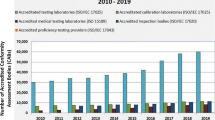Abstract
The Organisation for the Prohibition of Chemical Weapons (OPCW) has been organising and conducting Official Proficiency Tests (PT) since 1996 in accordance with ILAC-G13 to certify laboratories for the analysis of authentic samples under the provision of Chemical Weapons Convention. The tests are part of a mechanism to ensure that there are laboratories that have proven competence in the analysis of chemicals related to the Convention. Laboratories that have successfully completed the tests are designated by the Director General of the OPCW for analysis of authentic samples. To maintain the Designated Laboratory status, a laboratory must take and pass at least one of the two proficiency tests offered per calendar year. Unlike many proficiency tests, the OPCW PT is qualitative, that is the laboratories must determine if any of a very large set (essentially infinite) of chemicals relevant to the Convention are present in the samples. The tests are organised with the assistance of two laboratories, one preparing the test samples, and the other evaluating the test results. The paper provides an overview of the current status of these PTs and outlines salient features regarding procedure and scope of tests, selection of assisting laboratories, scoring and performance rating of participating labs. The emerging issues are also briefly discussed.



Similar content being viewed by others
References
Technical Secretariat of The Organisation for the Prohibition of Chemical Weapons (2005) Convention on the prohibition of the development, production, stockpiling and use of chemical weapons and on their destruction. http://www.opcw.org/chemical-weapons-convention/download-the-cwc
Mesilaakso M (2005) Chemical Weapons Convention chemicals analysis: sample collection, preparation and analytical methods. Wiley, Chichester. doi:10.1002/0470012285. Print ISBN: 9780470847565
Conference of the States Parties of the OPCW First Session Agenda item 51: criteria for the acceptable performance of laboratories in Proficiency Testing—C-I/DEC.62, dated 22 May 1997
Conference of the States Parties of the OPCW First Session Agenda item 51: criteria for the acceptable performance of laboratories in Proficiency Testing—C-I/DEC.61, dated 22 May 1997
Quality System Document of the OPCW: standard operating procedure for the organisation of the OPCW proficiency tests QDOC/LAB/SOP/PT01 issue no. 1 revision no. 2 dated 19 January 2009
ILAC Guidelines for the requirements for the competence of providers of proficiency testing schemes—ILAC-G13:08/2007
Quality System Document of the OPCW: work instruction for the preparation of samples for OPCW proficiency tests QDOC/LAB/WI/PT02 issue no. 1 revision no. 1 dated 15 September 2008
Quality System Document of the OPCW: work instruction for the evaluation of the results of OPCW proficiency tests QDOC/LAB/WI/PT03 issue no. 1 revision no. 1 dated 15 September 2008
Hendrikse J (2005) A comprehensive review of the official OPCW proficiency test in Mesilaakso M (ed) Chemical Weapons Convention chemicals analysis: sample collection, preparation and analytical methods. Wiley, Chichester. doi: 10.1002/0470012285.ch6
Author information
Authors and Affiliations
Corresponding author
Rights and permissions
About this article
Cite this article
Dubey, V., Velikeloth, S., Sliwakowski, M. et al. Official proficiency tests of the organisation for the prohibition of chemical weapons: current status and future directions. Accred Qual Assur 14, 431–437 (2009). https://doi.org/10.1007/s00769-009-0520-0
Received:
Accepted:
Published:
Issue Date:
DOI: https://doi.org/10.1007/s00769-009-0520-0




